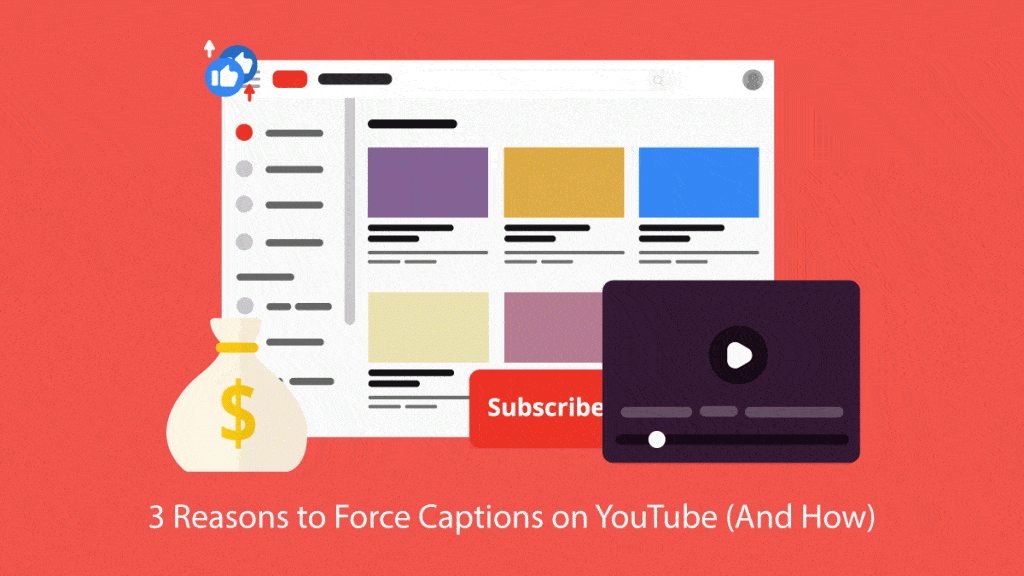How to Force Captions on YouTube
Concerned about issues like sound quality or accessibility in video content? Forced captions are an effective way to make things easier for your audience.

When thinking about closed captions on videos, we tend to consider them an optional setting. However, YouTube makes it possible to “force captions”, which turns them on automatically. If you’re concerned about issues like sound quality or accessibility in your video content, forced captions are a real and effective way to make things easier for your audience. Read on for why and how to turn YouTube captions on by default.
Why Should I Force YouTube Captions?
There are several reasons your clips could benefit from default captions. It’s important to note that while your videos may already have optional captions, some viewers may not think or know how to turn them on. If they don’t, they may face issues like:
- Poor Audio Quality
- Difficulty Understanding a Speaker
- Accessibility Trouble
Poor Audio Quality
It’s not always possible to produce videos with pristine sound – ask anyone working in journalism. They’ll be sure to tell you that background noise is part of a day’s work.
If you’re struggling to differentiate a subject’s words from the background ambience, chances are your viewers are too.
If you’re shooting outside in a large crowd, there may be additional sound that can garble the speaker’s words. Perhaps you got some great footage, only to discover that you were using faulty microphone equipment.
Whatever the reason, if you’re struggling to differentiate a subject’s words from the background ambience, chances are your viewers are too. In this scenario, it may be helpful to use forced captions.
Difficulty Understanding a Speaker
Trouble comprehending a speaker may be due to several reasons. If the person has a particularly thick accent or is speaking in a second language, captions will ensure that their message gets across intact.
Another reason speakers may be difficult to understand is the speed rate of speech. For instance, native New Yorkers may have no trouble understanding one another on the street, but if you don’t have the ear for East Coast speak it can be a little tough to follow. In those cases, captions form a short but important bridge.
In the end, forced captions present opportunities for greater engagement and comprehension of your content for viewers everywhere.
Lastly, if your speaker is discussing a topic that is particularly complex, your viewers may be left in the dust when it comes to specific terms with which they are unfamiliar. Forcing captions can improve comprehension and make the video more valuable for viewers.
Accessibility Trouble
If your viewer is hard or hearing or not a native speaker of the language in your video, forcing captions is a way to improve inclusivity. These viewers will not only be able to best comprehend your clip’s information, but by making the captions a default setting they’ll feel more welcomed and at home with your content.
In the end, forced captions present opportunities for greater engagement and comprehension of your content for viewers everywhere.
How to Force YouTube Closed Captions
Assuming you’ve already linked a transcript caption file with your video, you’ll just need to follow a few simple steps to force captions to appear on any YouTube clip.
- Log in to your YouTube account
- Open the Video Manager and select “Edit” then “Info and Settings” that corresponds with the desired video
- Under the “Basic Info” tab select the “Tags” option and add the following code:
yt:cc=on
If you’re working with a YouTube embed code for a website, you’ll need to add the following code inside to the end of the URL inside the iframe:
?cc_load_policy=1
As an example, the resulting embed code would look like this:

The Final Word of Forcing YouTube Captions
For a number of reasons, it’s increasingly common to watch online videos with captions turned on. By forcing captions to appear by default, you overcome the difficulties associated with poor audio quality and accessibility.
Best of all, it only takes a couple short lines of code to ensure all viewers will see captions. If you need any help with accurate captioning or integrating them into your current video library, we’re here to help, including with closed captioning on YouTube TV!
Subscribe to The Rev Blog
Sign up to get Rev content delivered straight to your inbox.



